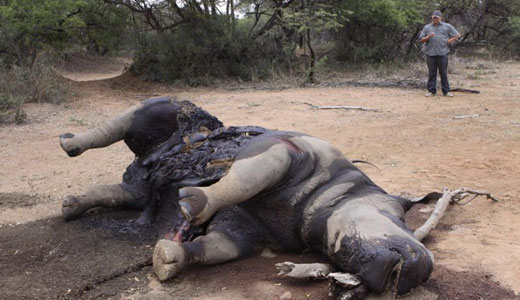
The Finfoot Game Reserve in Vaalkop Dam, South Africa became the sight of animal cruelty and bloodshed this month, when poachers killed eight rhinos with rifle shots to their lungs and hearts. The goal was to collect the animals’ horns for Asian buyers, who falsely believe they have medicinal properties.
With at least 588 rhinos killed this year alone, the illegal wildlife trade seems to show no signs of slowing, and experts warn that soon more rhinos will be killed than born.
The latest rhino-killing atrocity occurred during the same month that U.S. Secretary of State Hillary Clinton announced the implementation of a major U.S. strategy to curb the illegal wildlife trade – in particular, poaching. As part of the announcement, Clinton had spoken about wildlife “being targeted and killed in Asia and Africa,” and noted that the situation is a worldwide problem.
Marc Lappeman, who runs the Finfoot reserve along with his father, has taken matters into his own hands in order to fight poaching. He began employing armed vigilante patrols in order to protect the remaining rhinos. “This is a full-on war we are fighting,” he said. “We here are willing to die for these animals.”
The fact that rhinos are being slaughtered in South Africa, of all places, is particularly disturbing given the history of the whole affair. In the 1900s, rhinos in other parts of Africa were nearly hunted to extinction. In the 1960s, however, conservation efforts began, and many rhinos were airlifted to South Africa, which at the time was seen as a last place of refuge for the endangered species. Indeed, the population grew to such an extent that 90 percent of all rhinos worldwide now live in South Africa – but now, the country is a major poaching hub, which can only spell serious trouble for the animals.
Even amongst conservationists, there is a failure to realize that rhinos are perhaps in their final days of existence. As poaching continues as a profitable underground industry, this probability will become a certainty unless counter-measures are taken. In November 2011, the western black rhino was officially declared extinct by the International Union for the Conservation of Nature. The organization added that the white rhino was “possibly extinct in the wild,” and that Vietnam’s Javan rhino is almost certainly extinct; poachers are believed to have killed the last one in 2010.
“A lack of political support and willpower for conservation efforts in many rhino habitats, international organized crime groups targeting rhinos, and increasing illegal demand for rhino horns and commercial poaching are the main threats,” said the IUCN in an official statement.
Wildlife trade monitoring network TRAFFIC observed a steady yearly increase by a hundred or more in South African rhino poachings, based on statistics collected by the country’s Department of Environmental Affairs. “That the year-on-year rhino poaching losses have continued to grow in the face of heightened awareness, constant media attention, and concerted law enforcement effort is a testament to just how pervasive and gripping the rhino crisis in South Africa has become,” wrote TRAFFIC in a report in made during August 2012. “If poaching continues to increase annually, then eventually deaths will exceed births and rhino numbers in South Africa will fall.”
Government statistics show that the majority of the killings occur in parks, with the massive Kruger National Park being the main one. Kruger is on the edge of the country, bordered by Mozambique and Zimbabwe, where poachers can easily cross the border and wage attacks on the local rhino population.
Julian Rademeyer, a journalist who wrote Killing for Profit, a new book on rhino poaching, concluded, “The problem with [South African] law enforcement strategies is that they end where our border ends. Poaching will probably get a lot worse before it gets better.”
Photo: A rhino carcass lies on the ground near Tantanana, South Africa. Denis Farrell/AP












Comments